|
==============================================================================
TOPIC: North Dakota Forests
http://groups.google.com/group/entstrees/browse_thread/thread/86727802350053a0?hl=en
==============================================================================
== 1 of 1 ==
Date: Mon, Jan 28 2008 9:36 pm
From: "Edward Frank"
I spent two days visiting Theodore Roosevelt National Park http://www.nps.gov/thro/
in western North Dakota in August 2005. North Dakota is dominated by
prairie but does have some trees. They are mostly found along
rivers, streams, and lakes within the state. The highlight of the
park are the badlands of the Little Missouri River that passes
through the park. The park itself is divided into two sections,
north and south units. The river provides water for one of the
better collections of trees in the state. This page provides a
listing of the 102 most common of the 400 plant species found in the
park. http://www.nps.gov/thro/naturescience/common-plant-list.htm
there are only 5 of the most common trees listed, but there are
surely more species found within the park. Grasses dominate the land
surface, with trees and shrubs located in the hollows and along the
streams and river.
The most prominent memory of driving across the state were the
"linear forests" between the fields. Trees planted as
windbreaks separated the fields. The other memory was needing to
stop every few miles to clean the bug splatters from my windshield.
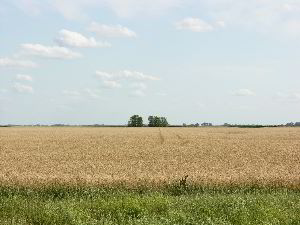
North Dakota Forest
|
Trees
|
|
|
|
|
Common
Name
|
Scientific
Name
|
Family
|
Habitat
|
|
American
elm
|
Ulmus
americana
|
Elm
|
Riverbottom,
draws
|
|
Box elder
|
Acer
negundo
|
Maple
|
Riverbottom
|
|
Cottonwood
|
Populus
deltoides
|
Willow
|
Riverbottom
|
|
Green ash
|
Fraxinus
pennsylvanica
|
Olive
|
Draws,
riverbottom
|
|
Rocky
Mountain juniper/cedar
|
Juniperus
scopulorum
|
Cypress
|
North-facing
slopes
|
|
|
|
|
|
|
Shrubs
|
|
|
Flowering
|
Flower
|
|
Common
Name
|
Scientific
Name
|
Family
|
Time
|
Color
|
|
Big sage/
Three-toothed sage
|
Artemisia
tridentata
|
Aster
|
|
|
I took several hundred photos in the park and have some good
shots of various habitats and plant species. I want to share with my
fellow ENTS.
Trees growing along the Little Missouri River. They are dominated
by cottonwood.
Rocky Mountain Juniper/Cedar
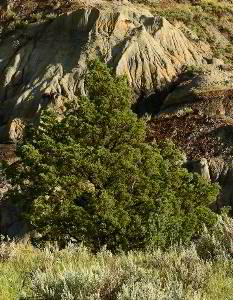
Rocky Mountain Juniper/Cedar |
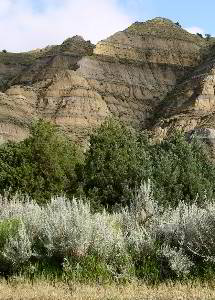
Big Sage |
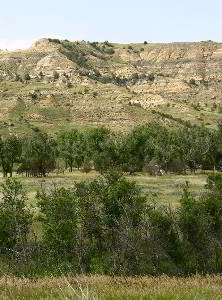
Cottonwood trees |
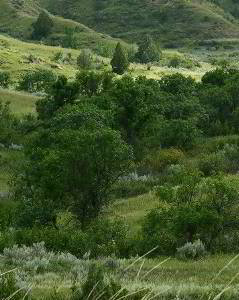
Cottonwood trees |
|
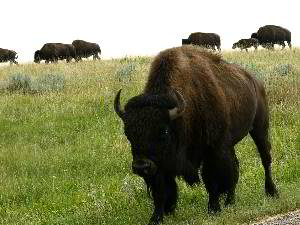
Some local wildlife amongst the grassy plains
|
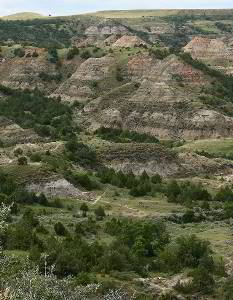 |
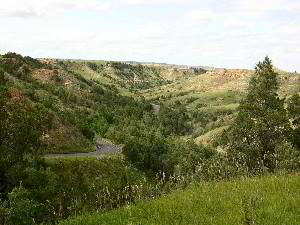 |
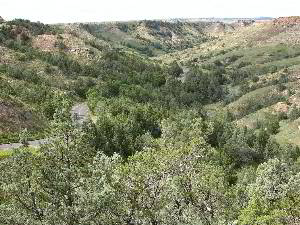 |
I am sure a few days of measurement by ENTS could document most of
the species in the park. Here are some facts about North Dakota
forests for further reading:
North Dakota is the countries least forested state by percentage.
Less than 1% of the state is forested. The North Dakota Forest
Service Website http://www.ndsu.nodak.edu/ndsu/lbakken/forest/ndfs_home.htm
states:
"North Dakota was considered part of the Great American
Desert. With hundreds of years of annual prairie fires in this
semi-arid climate, the grasslands became established and trees had
difficulty competing. The natural woodlands of North Dakota covered
about 700,000 acres, spread across the state. One of every 100 acres
is naturally forested. Forests and other woody vegetation are
generally confined to moist riparian sites along lakes, rivers, and
streams."
"The native forests are characterized by both eastern and
western forest types. North Dakota forests are comprised of four
major types: elm-ash-cottonwood, aspen, oak and ponderosa pine.
Elm-ash-cottonwood, the most abundant eastern forest type occur in
riparian areas along the Missouri, Red and Sheyenne Rivers. Aspen,
and the less extensive oak type, are concentrated in the Turtle
Mountains, the Pembina Hills and the Devils Lake region. The state's
smallest forest type, ponderosa pine, is limited to the Badlands of
western North Dakota."
The North Dakota Forest Service has a long history in the state. A
Brief History of the North Dakota Forest Service http://www.ndsu.nodak.edu/ndsu/lbakken/forest/doc/history_ndfs.pdf
1.22 MB
It might be surprising to people, but despite the small percentage
of trees the state has a Big Tree Program live and well: The 2006
Register of Champion Trees is available here in PDF format (2.15MB).
http://www.ndsu.nodak.edu/ndsu/lbakken/forest/infoed/doc/champ_tree_06.pdf
Included among the Big Trees on the list are some historic
cottonwood trees:
The giant cottonwood trees along the Missouri River near Washburn
in Smith Grove will be recognized as living witnesses to the Lewis
and Clark Expedition. The trees - towering 100 feet above the forest
floor and more than 250 years old - have been officially accepted to
the National Register of Historic Trees! http://www.ndsu.nodak.edu/ndsu/lbakken/forest/infoed/doc/lewis_clark.pdf
Edward Frank
"I am not bound to please thee with my answers."
William Shakespeare
|